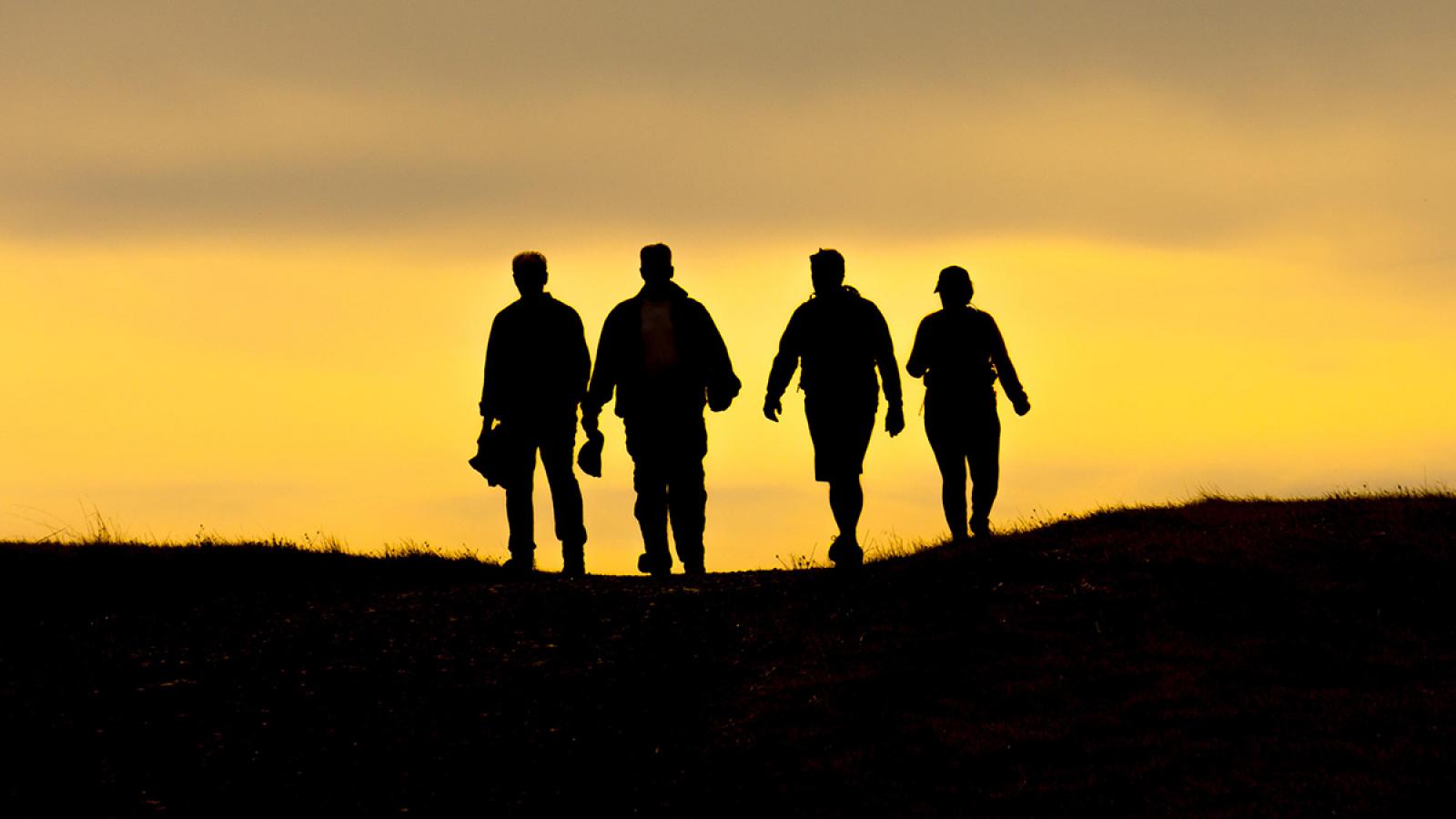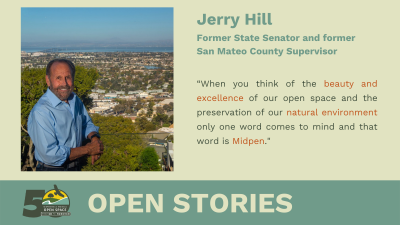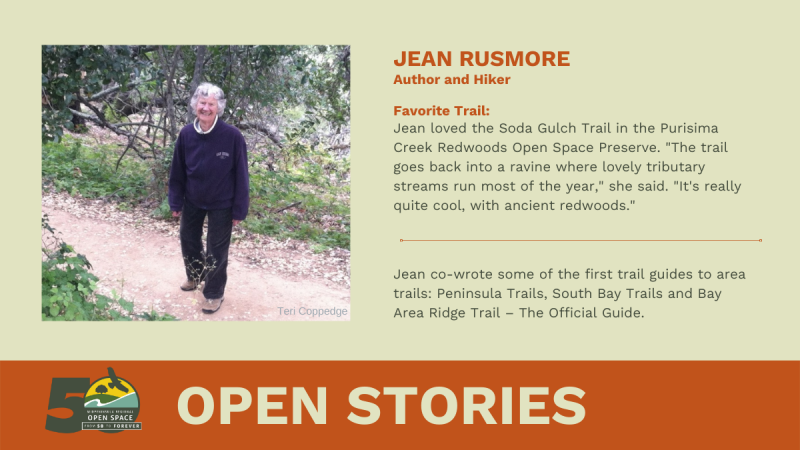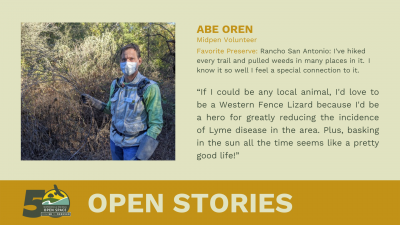In honor of our 50th Anniversary, and to help tell the story of 50 years of open space protection, restoration and enjoyment, we are delighted to bring you this series we’re calling Open Stories, a collection of conversations about the many ways to connect with nature and your public open space.

You may not know local resident Karl Gohl personally, but if an image featured in a Midpen newsletter, on our website or gracing the walls of our office lobby in large format has stopped you in your tracks, you’ve likely appreciated his artful nature photography.
“My wife and I have been hiking in Midpen preserves since the 1970s, and we have always found them to be full of interesting things and beautiful scenery. The advent of digital photography gave me the freedom to take lots of pictures in the preserves,” Gohl said.
From the smallest butterfly, wildflower and leaf to dramatic panoramic landscapes, Gohl has generously donated hundreds of images to Midpen over the last two decades that explore the beauty and biodiversity of Midpen preserves, and invite others to find meaningful connection with nature, too. Thank you, Karl!
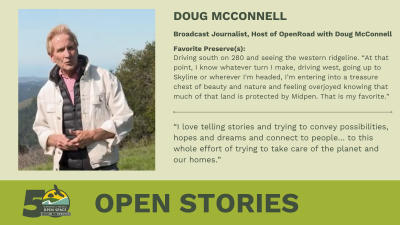
In his heart, Doug McConnell has two long-held passions: nature and storytelling. These interests have helped guide him through his storied career as a broadcast journalist. McConnell has produced and hosted multiple local and national specials, news reports and long-running nature series including Bay Area Backroads for 16 years, Mac and Mutley in the 1980s and 1990s and OpenRoad with Doug McConnell coming up on its ninth season on NBC Bay Area.
“Getting a chance to do what I have been now doing for so many decades, which is to go wander around, usually with a small camera team and put the spotlight on great people, great places and the wonderful people doing great things on our behalf, has really been a way for me to combine my two passions in life,” he explained.
McConnell’s interests in environmental protection and the natural world were instilled at an early age. He would travel up and down the state marveling at the serene landscapes of the Sierra Nevada Mountains, California deserts and redwood forests. “I fell in love with the diversity of the state,” he said. “The beauty, the natural world, you know, I spent a lot of my growing up years and places like Yosemite in the, you know, Sequoia and Kings Canyon… I just fell in love with California, fell in love with nature.”
His interest as a journalist sprouted from his love of storytelling, passed down from his father and grandfather. “I was always a kid who loved stories. I loved it. You know, I love to read them, but I also loved to hear people tell stories,” he said. His environmental journalism career took him across the globe. From Eastern Europe, to Africa, South and Central America then to Alaska for many years. However, following the birth of his first child, he and his wife wanted to settle down and make some roots and the Bay Area came calling.
“The ecological diversity here and, you know, atmosphere and climatic diversity is huge and wonderful,” he said. “It is just endlessly sort of engaging and entertaining for me.”
As he approaches his 40th anniversary on the Bay Area airwaves, it is clear McConnell hasn’t lost any of of his engagement with the land. He recently wrapped up the 13th season of OpenRoad and is already hard at work on the next season. Additionally, McConnell and his production company wrapped up an hour-long documentary special for Midpen’s 50th Anniversary which will air on NBCBayArea on December 24 at 4 p.m. and December 25 at 10 p.m.
After all this work bringing nature stories to the public he remains humble and credits the friends and agencies he works with, “It's really the people we find and feature who are the ones who deserve the credit and they inspire me. If I can play a small role and kind of bringing their voices into people's lives, that's terrific.”
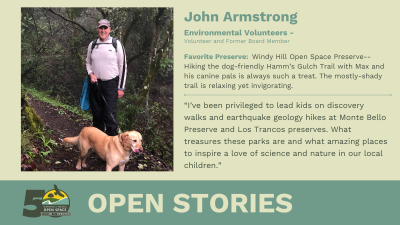
John Armstrong grew up on the Peninsula, spending many years hiking at Pearson-Arastradero Preserve, Foothills Park, and Windy Hill Preserve.
After a career as a financial analyst Armstrong went on to serve as a board member and a volunteer for Environmental Volunteers. Like Midpen, the nonprofit organization was founded in 1972 and is dedicated to the education of children and adults on environmental responsibility through hands-on learning. “I’ve been privileged to lead kids on discovery walks and earthquake geology hikes at Monte Bello and Los Trancos preserves” he says. “What treasures these parks are and what amazing places to inspire a love of science and nature in our local children.”
Reflecting on the legacy of the two organizations, Armstrong expresses his gratitude. “I’m always thankful for the foresight of those who set aside these spaces and to the founders of the Environmental Volunteers who, 50 years ago, saw the need to provide places for students to get to see nature; so they could experience it, know it, enjoy it, and grow to take care of it.”
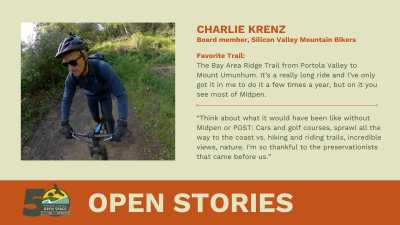
An avid mountain biker, Charlie Krenz serves on the Board of Directors for the Silicon Valley Mountain Bikers, a non-profit promoting mountain bike recreation and establishing sustainable access throughout Santa Clara and San Mateo Counties. He is a passionate advocate for responsible mountain bike use and the preservation of open space.
“I just feel more at home in a natural ecosystem. I feel like if we're using the lands in a sustainable way, we’re thinking ahead for those who will come after us,” says Charlie. “Think about what it would have been like without Midpen and POST: Cars and golf courses, sprawl all the way to the coast vs hiking and riding trails, incredible views, nature. I’m so thankful to the preservationists that came before us.”
An amateur videographer, Charlie partnered with Midpen to create Stories of Mt Umunhum for the opening of the iconic mountain in 2017. “One of my favorite rides is along the Bay Area Ridge Trail from Portola Valley to Mount Umunhum. It’s a really long ride and I’ve only got it in me to do it a few times a year,” he confesses. “But on it you see most of Midpen: Grasslands and bay views from Windy Hill, ferns and creek side moss along Peter’s Creek, coastal views near the Stegner bench, chaparral and views to Monterey from Umunhum. Everything in one ride. It’s like our own National Park wrapping around the South Bay.”
Charlie has also lobbied on behalf of Alpine Road, a popular mountain bike route. “It was built on the cheap in 1895 and has been crumbling into Corte Madera Creek ever since,” he explains. “I’m very pleased to see how Midpen has fixed up much of the route and agreed to incorporate it into the Coal Creek Open Space.”
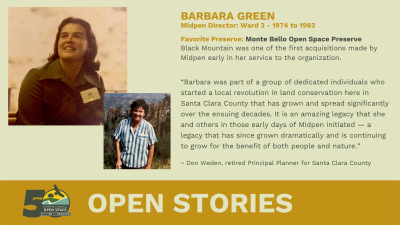
Barbara Green’s first elected position was as one of Midpen’s first board members in 1974, serving Ward 3 until 1983. After her time at Midpen, she continued to channel her interest in politics and passion for the environment into an over 30-year career in land use planning and open space protection, serving in elected and appointed positions in the Bay Area and later in Truckee. She took great pride in knowing that she could help change the fate of a piece of land by transferring it from urban development to permanent open space. Her contributions were far reaching as she served on multiple boards including San Francisco Bay Trail Commission, Committee for Green Foothills, Trail Center, League to Save Lake Tahoe, and Truckee Donner Land Trust.
“Barbara was part of a group of dedicated individuals who started a local revolution in land conservation here in Santa Clara County that has grown and spread significantly over the ensuing decades,” said Don Weden. “It is an amazing legacy that she and others in those early days of Midpen initiated — a legacy that has since grown dramatically and is continuing to grow for the benefit of both people and nature.”
Barbara passed away last month at the age of 84. Her greatest passions were the outdoors and people. Her appreciation for nature and outdoor recreation made her an ardent advocate and leader in open space protection. We are grateful to her dedication and commitment to the land and the people who love it.
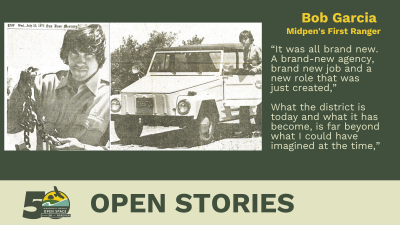
Bob Garcia was studying biology at San Jose State University in 1975 when he got the call from staff at Midpen, then a newly created public agency, in need of someone to help build out the ranger program and get eyes and ears on the ground in the first open space preserves. At the time, the agency was still known as the Midpeninsula Regional Parks District. When Garcia joined, there were fewer than 10 total employees.
Garcia most often patrolled the newly acquired lands on the lookout for trespassers, whether they be illegally camping or riding motorcycles through the protected open space lands. While his main focus was to patrol, he also performed maintenance duties. In those very early days, he was missing much of the necessary equipment, such as a two-way radio, a standardized uniform with a badge, and an all-terrain vehicle capable of traversing dirt roads.
“It was all brand new. A brand-new agency, brand-new job and a new role that was just created. Some of my favorite memories are of doing the simple things like selecting the first Midpen ranger uniforms and ordering a patrol vehicle,” Garcia explained. “The first Midpen vehicle wasn’t ‘The Thing’ [pictured above], it was actually my personal Volkswagen bug.”
What Midpen may not have had in terms of equipment and supplies, was more than made up for with tenacity and dedication.
“We all had a shared common vision,” Garcia recounted. “What Midpen is today, and what it has become, is far beyond what I could have imagined at the time.”
Now retired, Garcia still actively spends time outdoors in Midpen preserves, including riding his horse through Thornewood Open Space Preserve.
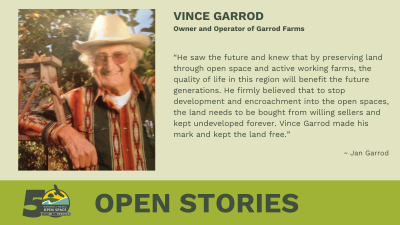
Vince Garrod, former owner and operator of Garrod Farms in Saratoga, was a conservationist and a prominent member of the Saratoga community. Born in 1918 and raised in Saratoga, he spent his life on the family farm and after growing prunes and apricots for 50 years, he developed a horse livery business.
With a keen eye on local land use, Vince played an active role in conservation and supported the formation of the Midpeninsula Regional Open Space District. He saw the rapid development along the Santa Clara Valley result in the loss of farmland and open space and wanted to ensure preservation of the cherished valley views and bridle paths for the public to enjoy. He was instrumental in the formation and growth of multiple preserves – both Fremont Older and Long Ridge preserves contain former Garrod family land. Vince also worked with the Picchetti family to sell their historic winery property to Midpen in 1976, establishing Picchetti Ranch Open Space Preserve.
Since Vince passed away in 2012, his legacy lives on through his family and his longstanding contributions to land preservation. Vince’s son, Jan Garrod, remembers his dad by saying, “He saw the future and knew that by preserving land through open space and active working farms, the quality of life in this region will benefit the future generations. He firmly believed that to stop development and encroachment into the open spaces, the land needs to be bought from willing sellers and kept undeveloped forever. Vince Garrod made his mark and kept the land free.”
The next time you find yourself enjoying one of these preserves, take a moment to enjoy the history and years of work that have gone into its protection.

Lily Lee was one of the driving forces behind the clean-up of Cooley Landing, working for the City of East Palo Alto, on loan from the U.S. Environmental Protection Agency, to help facilitate cleanup of the former toxic dump and raise millions of dollars towards implementation of the project. Later, sponsored by the Packard Foundation, she managed the project full-time during the completion of the remediation and restoration effort.
“The strong community leadership and passion for Cooley Landing inspired me and many other partners to do our parts to make East Palo Alto’s vision a reality,” said Lily.
Over the years, Cooley Landing has had many uses – it began as a deep water port in the 1800s, served as a County dump from 1932 to 1958, was the site of a ship repair business through the 1990. The adjacent Ravenswood Open Space Preserve was a salt production pond from the 1950s to 1981 before opening to the public in 1989. Now the two bayside properties provide wildlife with a thriving wetland habit and the community with a location for birdwatching, family adventures and an easy-access pedestrian and bicycle trail.
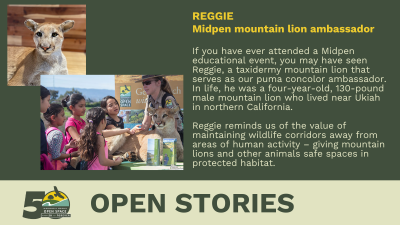
If you have ever attended a Midpen educational event, you may have seen Reggie, a taxidermy mountain lion that serves as Midpen’s Puma concolor ambassador. In life, Reggie was a four-year-old, 130-pound male mountain lion who lived near Ukiah in northern California. He has been with Midpen since 1997 after we acquired him from the Department of Fish and Wildlife. When he is not out helping us educate the public, he resides in the front lobby of our office.
Reggie reminds us of the value of maintaining wildlife corridors away from areas of human activity – giving mountain lions and other animals safe spaces in protected habitat.
Midpen has a big role in protecting species such as mountain lions. Not only does Midpen protect a large greenbelt of habitat for animals like Reggie, but the agency also is working with the University of Santa Cruz Puma Project to learn more about how mountain lions use open space lands that are frequently visited by people. This will help us better understand the factors that influence human-mountain lion interactions so that animals like Reggie can stay safe!
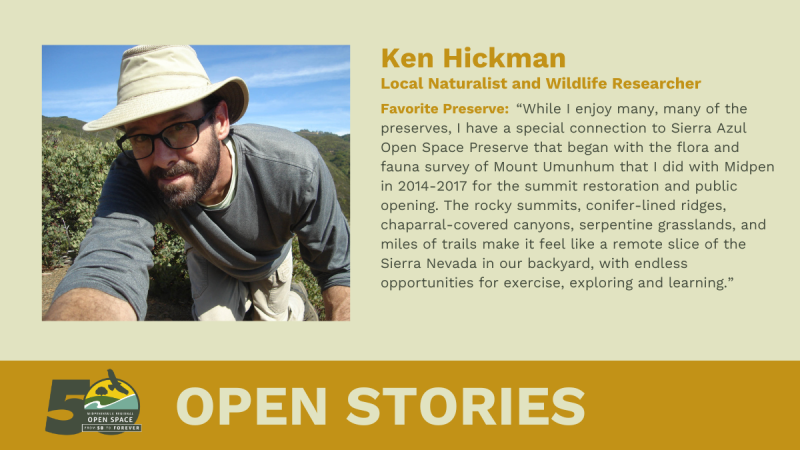
Mountain lions, badgers, gray foxes, coyotes and dusky-footed woodrats, oh my! Ken Hickman has captured amazing photos of all these charismatic species and more on his array of wildlife cameras. Ken specializes in building high-quality, sensor-triggered cameras that can last in the field for many months while they photograph animals that pass by. He has been conducting wildlife surveys throughout California for nearly 15 years, working with many different public and private agencies, including Midpen.
“I began my partnership with Midpen in 2012 after volunteering for 3 years as a scientific aide with the CA Department of Fish & Wildlife. Encouraged and supported by Midpen biologist Cindy Roessler, I applied for a permit to similarly conduct wildlife research using camera traps in Midpen preserves, with the idea that I might be able to apply my time and expertise to help Midpen better understand the distribution and land-use of several secretive local species, including the American badger and Santa Cruz kangaroo rat.”
Though his work takes him all over the state, to many diverse and beautiful locations, the nature in the Santa Cruz Mountains has not yet gotten old for Ken! “I look forward to every outing in the preserves - the air, the exercise, and the wonder of ‘what will we see’ are continuously rejuvenating.”
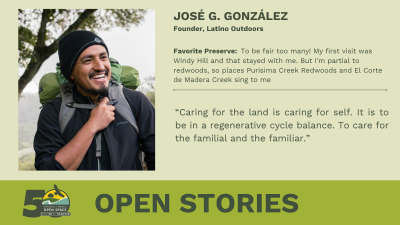
Upon graduating from the University of Michigan with a master’s degree in Natural Resources, José González noticed a lack of overlap between Latino-serving and conservation focused organizations. José’s passion to bridge this gap began in 2013 as an online blog that has grown into the national organization Latino Outdoors.
Latino Outdoors inspires to connect and engage Latino communities in the outdoors and embrace cultura y familia as part of the outdoor narrative, ensuring our history, heritage, and leadership are valued and represented.
José says it’s the ability to “connect people to the outdoors and nature” that keeps him working in open space. To José, open spaces are a place of connection and reconnection to ourselves and to land that provides an abundance of holistic benefits. José remains involved in Latino Outdoors and is constantly working to diversify outdoor and conservation programs throughout the region. Midpen partners with Latino Outdoors throughout the year on outdoor activities and online educational presentations.
To learn more about the great work of Latino Outdoors, visit latinooutdoors.org.
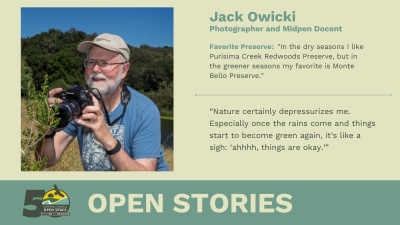
When Jack Owicki took a step back from his intense career in Silicon Valley biotech, he wanted to go back to his youth and reconnect with nature. “I began spending a lot of time outdoors, and the places I spent the most time were Midpen preserves.” In order to give back to the lands he loves and to connect with like-minded people, Jack joined the 2008 class of Midpen docent-naturalists. “I wanted to give back and be able to help others learn about and enjoy nature,” said Jack.
Jack’s favorite critters are often ones that give others the heebie-jeebies. “I tend to like creatures that most people don’t like. Mostly that involves invertebrates. More than anything else I like arachnids like spiders, scorpions and solifugids.”
As a docent, his favorite hikes to lead are ones where he can teach other people about the amazing world of arachnids. “The annual Arachnophilia hike is my favorite hike to lead,” Jack explained. “That activity is timed mostly to try to catch the mating wandering of the male tarantulas and Calisoga spiders.”
Jack is also an avid nature photographer, who shoots amazing photos all around the Bay Area. “I am mostly self-taught, but throughout my life I have tended to be mostly self-taught. Since I have backed off of my career, I have had more time to devote to learning about nature photography and such things.”
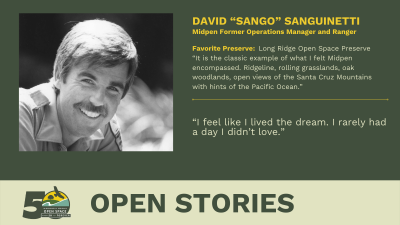
As one of the “original nine” rangers hired by Midpen, David Sanguinetti, or “Sango” as he was more commonly known around the organization, has a thorough recollection of the early days at Midpen. “It was like a startup,” he explained. “We did law enforcement; we did trail building and maintenance. We did it all. We were true generalist rangers. We had the unique opportunity to create the culture and style of the agency and programs.”
Hired in 1980, eight years after Santa Clara County voters voted to create what is now known as Midpeninsula Regional Open Space District, Sango witnessed the evolution of the agency from its original six preserves to 26. In his time, the rangers went from what he described as a “helter-skelter crew” to a professional team that had matching uniforms, well-maintained vehicles, and a reputation for approaching all visitors with a willingness to help and provide a touchpoint for preserve-goers.
At age 17, he discovered his love of the mountains and set his sights on becoming a ranger. “There was something magnetic [about the Santa Cruz Mountains],” he explained. “It just drew me in.” While working as a radio dispatch for the Aptos Fire District, he came across a job ad in the Santa Cruz Sentinel for a ranger at a small agency he wasn’t familiar with. “I realized that I had hit the jackpot and this was a perfect fit and I never left,” he said. “I committed to spending my career –almost 34 years– to the growth and protection of District Lands in the Santa Cruz Mountains.”
However, being one of the original rangers for Midpen, didn’t come without its challenges. As a new agency with new lands, neighbors were often resistant to the agency. “We called it the Wild West,” Sango explained as he recounted stories of being greeted by the “one-finger salute.”
“It requires the development of what I call a '6th Sense’ due to the nature of the job requiring rangers to work alone at all times of the day, in remote places, with long response backup. We needed to know our surroundings intimately so that we could operate safely when making contacts, especially after dark.”
One of the key components of Sango’s job was to make contact and develop relationships with neighbors and work with them to create solutions showing the value of Midpen. “Everywhere we went, we had to win them over. It was endless in the 80s and 90s, he explained. “Even the 2000s when we went to the Coastside, it was like, here we go again. I think by the time I left 2013 we won that one too.”
Going the extra mile and giving a personal touch, he explained, was the best a way to work with neighbors. He explained, “Our job is to be good neighbors to take care of the land, to deal with issues that are affecting you as well as protecting that land.” Sango took this charge to heart. “I've always been on a mission. I never did it for money. I did it because I believed it and I loved it. I couldn't believe that I was getting paid to do it. I feel like I lived the dream. I rarely had a day I didn’t love.”
Now retired and living in the Santa Cruz area, he serves on the Parks & Recreation Commission for the City of Scotts Valley. “It’s a way to scratch my open space itch,” he said as he proudly recounted his efforts to help the city establish three open space preserves.
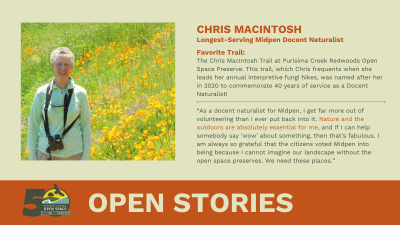
Midpen’s docent naturalist program has long provided enriched experiences that connect people to each other and the essential benefits of time spent outdoors. Among the many nature enthusiasts generously giving of their time to plan and lead free guided activities in Midpen preserves, Midpen Docent Naturalist Chris MacIntosh has been at it longer than any other.
In 1979, MacIntosh was among one of Midpen’s first graduating classes of docent naturalists, who go through a rigorous training program. To this day, after more than four decades, she continues to take the public on enriching outings that feature a wide variety of topics including rainy-season hikes in search of fungi, birding by the bay and many other adventures and wanderings. She also participates in Midpen’s volunteer trail patrol program.
MacIntosh’s path from her native Britain to guiding the public along Midpen’s trails was a winding one, including coming to the U.S. to attend graduate school on the East Coast, living in Manhattan and working several summers for the concession at Yellowstone National Park. Alongside a professional career as an administrative associate, she has made time to volunteer not only for Midpen, but also for the Loma Prieta Chapter of the Sierra Club and the local Sequoia Audubon Society, among other groups.
A true gift to the community, MacIntosh continues to volunteer as a docent naturalist out on the Midpen trails, enthusiastically sharing her curiosity, knowledge and sense of awe and wonder in nature with the public. Thank you, Chris!
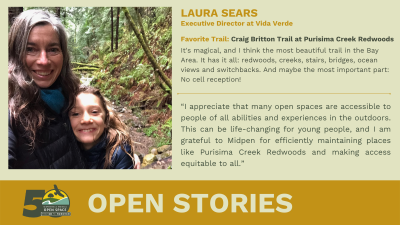
Born and raised in rural Kentucky, Laura Sears graduated from Colorado College with a degree in Geology in 1999. She was a high school special education teacher for two years before moving to California in 2001 and co-founding Vida Verde, a non-profit organization promoting educational equity by providing free, overnight environmental learning experiences for students who don’t otherwise get the opportunity,with her husband Shawn.
Laura sees the work Vida Verde does with young people as extremely important in influencing the long-term impacts of protecting open spaces. "Both at Vida Verde and as parents, we try to model through our own excitement, awe and wonder when in nature," Laura explains. Rather than lecturing or using fear about why it's important to preserve natural spaces, she has found that this wonder-based approach sparks a natural curiosity for kids and builds more intrinsic care and appreciation for the land and environment.
Through a thoughtful, culturally relevant, well-designed and passionately executed outdoor program, Vida Verde offers opportunities such as 3-day camps for 4th-6th graders and week-long summer leadership camps for teens. Currently serving as the Executive Director for Vida Verde, Laura's experiences in open space have given her a deep appreciation for the land that she infuses into her work every day. "Nature is healing," believes Laura. "We know this now more than ever."
Vida Verde is an active grantee in Midpen’s Grantmaking Program and has used their awarded funding to expand their immersive, multi-day experiences in nature for students from low-income communities. For more information about the vital programming taking place at Vida Verde, visit their website vveducation.org.
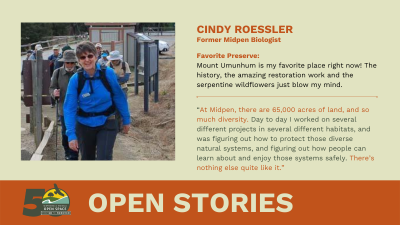
When Cindy Roessler started at Midpen she was one of only two biologists on staff, which meant there were a lot of acres for her to cover. Throughout her 15 years at Midpen, she worked on hundreds of projects that ranged from restoration planting to mountain lion research. “I learned a lot on the job. I love being a biologist because each day is always wonderfully different than you expect, there is always more to learn.”
After Cindy moved to staff housing on Midpen’s very first conservation grazing property, she began to learn even more about the complex ecosystems of the Santa Cruz Mountains. “By the time I moved there, I had close to 20 years of natural land management experience, and I thought I knew the preserves so well… But just living out on that piece of land for 10 years, spending entire weekends walking the property, being there every night and seeing the changes through the seasons, I saw a level of detail that I had not gotten the chance to see before.”
Though she has 15 years’ worth of projects under her belt, by far the most memorable for Cindy was her role in the discovery of a population of red-bellied newts in the Santa Cruz Mountains. Red-bellied newts’ range was originally described as four counties: Humboldt, Mendocino, Lake and Sonoma. “It was a big puzzle,” she said. “How did this salamander make a home in Santa Clara County, 80 miles away from its main population? That’s a long way for a little salamander to walk.” You can read about the saga of the red-bellied newt on Cindy’s blog: dipperanch.blogspot.com.
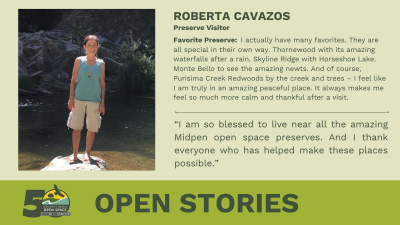
Roberta Cavazos regularly enjoys visiting a variety of preserves. “My husband and I try and visit one of the preserves every weekend. We always find something new and amazing on each visit,” she says. Even more special to her are the times she gets get to share the preserves with her grandchildren. “Seeing things through their eyes is such a fun experience. It brings out the kid in us.” She recalls many memorable visits, “we would count the banana slugs, and got to over 100 on one hike! Trying to name the different wildflowers and of course finding lizards on the way.”

One of our most precious natural resources. The sixth supervisor in San Mateo County. Lennie Roberts has been called many things over her 50+ year career as an environmental advocate. Most often, perhaps, simply: hero.
In 2009, Lennie was voted the Cox Conserves Hero for the Bay Area; in 2016, she received the Environmental Hero Award from the Loma Prieta chapter of the Sierra Club and in 2019 Bay Nature Magazine named her a local hero for her work to protect open space on the San Mateo County Coastside.
“Her legacy here on the coast is what you don’t see,” Midpen Board President Zoe Kersteen-Tucker says. “You don’t see thousands of houses sprawling up the mountainside. What you do see are the beautiful scenic vistas and the agricultural lands.”
As a volunteer legislative advocate for Green Foothills since 1978, Lennie is renowned for standing strong on principle while seeking middle ground.
“Lennie has been effective because she is able to identify what’s important, when to draw a line in the sand, and where to compromise or negotiate,” retired California Assemblymember Rich Gordon said when he was a member of the San Mateo County Board of Supervisors.
Without Lennie’s work, the Coastside would look very different today: luxury subdivisions, golf courses, a multilane freeway over Montara Mountain. Lennie was the author and cosponsor of Measure A, which voters passed in 1986. This “Coastal Protection Initiative,” gave 38 policies in the county’s 1980 Local Coastal Program the force of law that cannot be changed without voter approval.
Other achievements Lennie takes pride in are helping to create Midpen in 1972 and expanding its boundaries to San Mateo County in 1976. Green Foothills was about 10 years old, and Lennie had joined its board of directors in 1968. She and other Green Foothills leaders led the drive to collect 5,000 signatures to qualify Measure R for the ballot. Voters passed this “Room to Breathe Initiative” by nearly 68%, establishing Midpen.
Lennie and Green Foothills members were also instrumental in expanding Midpen’s boundaries to the Coastside in 2004 and helping to pass Measure AA to fund Midpen’s Vision Plan in 2014. She led advocacy efforts to stop suburban sprawl on lands that later became Midpen’s Russian Ridge, Purisima Creek Redwoods and Bear Creek Redwoods public open space preserves.
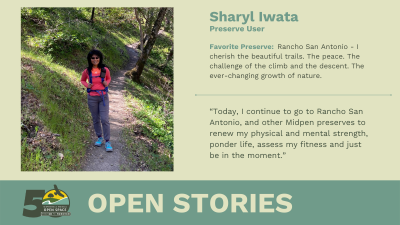
Sharyl Iwata has been a visitor of Midpen land at preserves like Rancho San Antonio County Park & Open Space Preserve for more than 20 years. In reflection, Sharyl describes what the preserve has meant to her, “It has been a place for so many activities that bring joy, balance, and comfort. It is going to ‘church’. It is where my friends and I would meet to go for runs, and hikes, and catch up, sweat, laugh, and support one another. It is where I would go to clear my head, get distracted by the looking at the water level in the creek, the deer, the wild turkeys, counting squirrels, poison oak, California Buckeye, and snakes. It is where I have run into so many other friends and colleagues.”
Sharyl explains how she’s seen the preserves change in more ways than one, “For years, I have taken pictures at Vista Point. I have noted that the trees have grown taller and obscured my view of San Francisco. Today, I continue to go to Rancho San Antonio, and other Midpen preserves to renew my physical and mental strength, ponder life, assess my fitness and just be in the moment. I appreciate that this is home to many plants and animals and we get to SHARE these beautiful places. We are visitors in their home.”
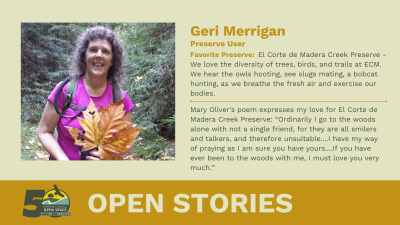
Geri Merrigan has been a frequent explorer in Midpen’s El Corte de Madera Creek Preserve for 20 years. She regularly shares the trail with her partner, Walter and remembers a unique experience this from this past January. “We saw a band of 100+ blue jays flitting from tree to tree in front of us as we walked down Timberview Trail,” she fondly recalled. “On that day, over six miles of trails, we saw 2-3 small, fluffy white owl feathers every 3-4 feet! Thousands of downy little feathers, far more than we have ever seen before.”
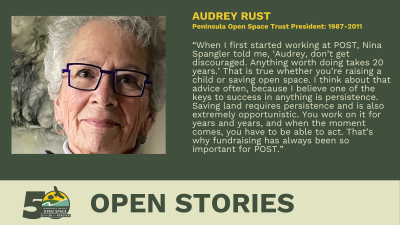
For Audrey Rust, former president of the Palo Alto-based nonprofit land trust Peninsula Open Space Trust (POST), a deep connection to nature and a desire to protect it goes back to childhood. As a teenager in Connecticut, she convinced developers building a road through the woods near her home to transplant some of the lady slipper orchids she loved, which have since been listed as a species of special concern, onto her mother’s property.
“They only lasted a few years, but it gave me a little boost,” she said.
Rust went on to a successful career in national fundraising for Yale University, Stanford University and eventually the Sierra Club. While Rust was honing her fundraising skills, Midpen’s first general manager, Herb Grench, proposed forming a private land trust that could work more nimbly with sellers, and raise money to supplement public funding for land conservation. This resulted in the creation of POST in 1977.
“Working at Stanford, and later Yale and the Sierra Club, helped me connect with many people on the Peninsula,” Rust said.
While working for the Sierra Club, Rust also got to know POST by serving on their citizens advisory committee, helping to plan for what is now Midpen’s Skyline Ridge Open Space Preserve. POST’s first executive director, Bob Augsburger, approached Rust twice over the course of nearly a decade suggesting she consider taking the lead at POST.
“I thought I would be there three or four years and I was there 24. It was the absolute best fit for me. We were accomplishing great things with really lasting benefits for the greater community and world.”
During Rust’s tenure as president, she led POST in raising millions of dollars and preserving 53,000 acres of open space land in the Bay Area, much of which has since been transferred to Midpen and POST’s other public agency partners to steward in perpetuity.
“We prioritized protecting land that connected to other open spaces for wildlife and trail corridors, not just because it was beautiful. If we’re asking people to contribute, it has to have a direct public benefit.”
Today, Rust is very concerned about the effects of climate change on people and the natural ecosystems that she and others have worked so hard to protect. She continues enjoying open space, along with her lifelong love of native plants, as part of a weekly hiking group she formed just before retiring from POST. Her favorite local trails to explore depend on the time of year.
“If you get to know the seasonality of places, you can get the best of them. It’s all about the weather in conjunction with nature. For example, when you walk out in the Monte Bello Open Space Preserve, that vista down the valley is breathtaking, especially when it’s slightly misty.”
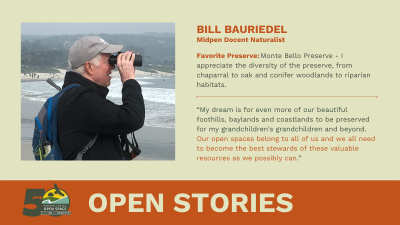
Bill Bauriedel has been visiting Midpen preserves for over 40 years, both as a visitor and as a docent naturalist. During his time, he’s had many memorable hikes, including one snowy day at Skyline Ridge, “It had snowed overnight and it was cold (at least by California standards) and we were the only ones at the preserve when we arrived,” he remembered. “We walked down to Horseshoe Lake and then out onto the Lambert Creek Trail. There was fresh snow on the trail and there were rabbit prints crossing the trail. It was totally silent and beautiful. We knew we had made the right decision to be there that day.”
Despite his years of experiences in the preserves, Bill describes what brings him back year after year; “There are so many surprises in our preserves. I love the diversity of the plants, insects, birds, reptiles, and animals.” Bill said, “we love to share what we have learned and the more we learn the more we want to know.”
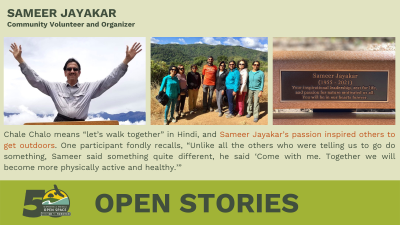
Chale Chalo means “let’s walk together” in Hindi and Sameer Jayakar’s passion inspired others to get walking together outdoors. Jayakar was a volunteer, donor and participant at the South Asian Heart Center at El Camino Hospital, where he worked to mobilize the community to become physically active through hiking and biking. Part of this included the popular Chale Chalo events that he organized throughout the region for over 15 years.
He painstakingly planned each event, motivating hundreds of community members to take to the trails week after week including walks at Rancho San Antonio, Windy Hill, St. Joseph’s Hill, Fremont Older, and Bear Creek Redwoods open space preserves. For each new trail, Sameer would first hike them with his wife Sunita, to get a feel for the terrain, elevation, distance and expected time to commitment so he could equip and engage others to join him. One participant fondly recalls, “Unlike all the others who were telling us to go do something, Sameer said something quite different, he said ‘Come with me. Together we will become more physically active and healthy.’”
Sameer passed away in March of 2021. This year his family and friends dedicated a bench at Rancho San Antonio County Park and Open Space Preserve in honor of his passion, inclusion and impact on the health of the community.
The next time you’re out on the open space trails keep an eye out for fellow hikers in vivid orange and maroon Chale Chalo t-shirts, and perhaps, take a moment to walk together.
He started his career in public service in the 1980’s as a community-minded homeowner and was eventually elected to the San Mateo City Council in 1991. Hill was elected to the San Mateo County Board of Supervisors in 1998, where he served for 10 years. He was elected to the California Assembly in 2008 where he served for 4 years until his election to the California Senate in 2012 and re-elected in 2016. During his time in Sacramento, Senator Hill authored numerous bills that included protection for mountain lions and legislation to help Midpen better manage its natural and working lands. He was always a steadfast supporter of the state’s environmental goals.
Senator Hill’s impact on Midpen has been significant. While on the county Board of Supervisors, he worked with fellow Board and Commission member Rich Gordon to enable the extension of Midpen into the San Mateo County coastal region in 2004 as commissioners for the San Mateo County Local Agency Formation Commission (LAFCo). Since then, the majority of Midpen’s land acquisitions have been within the Coastal Service Plan area that was adopted at that time.
In 2019 Senator Hill secured the appropriation of $2 million in budgeted state general funds for the District for the purposes of acquiring 587 acres of coastal grazing land and natural habitat at Gordon Ridge.
As to why Midpen open spaces and nature are important to him, Hill responds, “Midpen is an important part of my DNA in San Mateo County. When you think of the beauty and excellence of our open space and the preservation of our natural environment only one word comes to mind and that word is Midpen.”
He continued by saying, “As I reflect on my years of public service there is one decision that is probably the most impactful, sustainable decision I ever made. That decision was to advocate and support the inclusion of the entire San Mateo Coast into the Midpeninsula Regional Open Space District. I felt the significance of that decision then and still feel it today.”
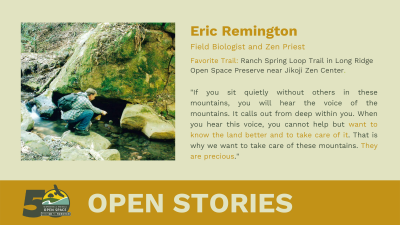
“If you go out to one of the preserves around here, there’s magic to be found,” says Eric Remington. Few folks would be more tuned-in to the magic than Remington, who has been exploring the Santa Cruz Mountain region in and around the preserves for more than 40 years.
At a young age, he would often join his father, a biology professor, on field research trips with graduate students where he developed a reputation for skill with a butterfly net. Living what he described as an “adventure-filled life,” he has long felt a connection to nature and at peace while communing with the wilderness.
As an ordained zen priest, for many years, Remington lived and taught at the Jikoji Zen Center surrounded by the Long Ridge Open Space Preserve. For decades he held a master key to the preserves, exploring and documenting the unique flora and fauna he discovered. He would share his findings with Midpen staff, providing helpful information for examining potential land acquisitions in a time before Midpen had a robust natural resources department.
Although he no longer lives at the zen center, he still teaches 3-4 classes a year, primarily about reconnecting with nature, which he says many people have lost. His first piece of advice, he explained is to, “turn off your phones and put away your guidebooks.” With the abundance of open space in the area, “you have to commune with the land,” and spend time in nature without an agenda.
“If you sit quietly without others in these mountains, you will hear the voice of the mountains. It calls out from deep within you. When you hear this voice, you cannot help but want to know the land better and to take care of it. That is why we want to take care of these mountains. They are precious.”
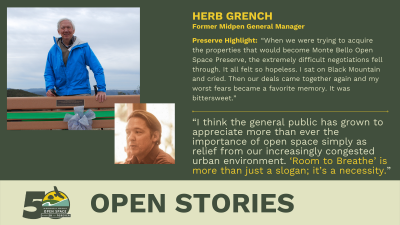
In 1973, not long after the formation of Midpen, Herb Grench became its first general manager. While working in his previous position at Lockheed as a nuclear physicist, he spent his personal time as a conservationist, serving as a Palo Alto planning commission member, a leader in the local Audubon society chapter and on the Committee for Green Foothills. Herb’s passion and determination made him the perfect fit for the role. “I just changed my avocation into a vocation,” he said at the time.
Herb began by helping Midpen set up headquarters, develop a basic policy and master plan, collect a modest property tax, and begin buying land for open space. “Although the District was created by the voters in 1972, we had no tax revenue for a year and a half,” said Herb. “Our supporter’s expectation (or our own) seemed to be that we’d start saving open space on Day One. My challenge was to build an organization and make some progress as soon as possible.
Herb counts the creation of the Peninsula Open Space Trust and its partnership among the high points of his career at Midpen. “Aside from the 30,000 acres of land preserved during my tenure, the accomplishment I’m most personally proud of is conceiving of POST and getting it going. It has been instrumental in not only saving land but also in building important public, political and landowner support for open space protection.”
When asked what he believes is the biggest shift in public perception about open space since the 70s, Herb says, “I think the general public has grown to appreciate more than ever the importance of open space simply as relief from our increasingly congested urban environment. ‘Room to Breathe’ is more than just a slogan; it’s a necessity.”
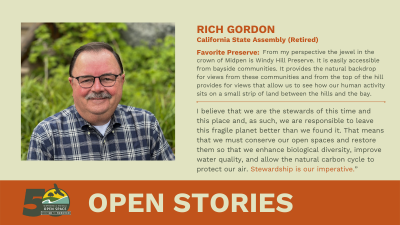
Midpen is a much bigger district thanks, in part, to former Assemblymember Rich Gordon.
For almost 30 years, Rich Gordon provided leadership and elected representation to the residents of San Mateo and Santa Clara County. In 1992 he was elected to the San Mateo County Board of Education. He was then elected the San Mateo County Board of Supervisors in 1997, serving for 13 years. Finally, in 2010, he joined the California State Assembly where he became one of the most productive legislators during his six-year tenure. Several of his signed bills helped Midpen improve its fiscal health and better manage its natural and working lands.
Throughout his time in office, Assemblymember Gordon consistently demonstrated his commitment to the environment and the agencies that support the mission of open space preservation and conservation through active support of environmental legislation.
In 2004, as a member of the San Mateo County Board of Supervisors and Local Agency Formation Commission (LAFCo), he worked with fellow Board and Commission member Jerry Hill to help enable the extension of the Midpeninsula Regional Open Space District into the San Mateo County coastal region. With the approval of the expansion, Midpen grew by almost 40 percent and in the 18 years since that approval, Midpen has acquired and manages over 13,000 acres of land in the coastside area.
As to why Midpen open spaces and nature are important to him, Gordon responds, “These open spaces define our place on the San Francisco Peninsula. They keep us connected to the land and all of its natural resources. Spending time in these open spaces renews us and provides a respite from the hectic pace of our daily lives.
He continued by saying, “It has been said that ‘the earth is not given to us by our parents, it is lent to us by our children.’ I believe that we are the stewards of this time and this place and, as such, we are responsible to leave this fragile planet better than we found it. That means that we must conserve our open spaces and restore them so that we enhance biological diversity, improve water quality, and allow the natural carbon cycle to protect our air. Stewardship is our imperative.”

Animals of all varieties have always fascinated Gabbie Burns, but birds are her calling. The excitement of birding and spending time in open spaces is a year-round love for Gabbie. “Spending time in open space is restorative for us”, believes Gabbie. “It nourishes our hearts, minds, and souls.
The crucial work Gabbie does at the San Francisco Bay Bird Observatory (SFBBO) centers around documenting the abundance and diversity of waterbird species to track changes through time and inform plans for the conservation of these animals. Her primary focus is birding lands that is included in the South Bay Salt Pond Restoration Project and surrounding areas.
Gabbie loves the protected salt marsh lands around the San Francisco Bay where she finds a wide variety of waterbird species due to the diverse habitat characteristics designed to sustain a wide variety of waterbirds, from summer breeding birds to winter migrants.
“They need and deserve to thrive on this planet every bit as much as we do,” she says. “It is our responsibility to protect space for them to do just that.”
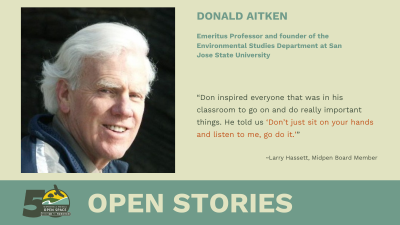
Open Stories remembers Donald Aitken who passed away this February at the age of 85. Aitken was an environmental pioneer who played an instrumental role in the establishment of multiple influential organizations. His contributions to the environmental community are a testament to what can grow and flourish when we work together for the greater good.
Aitken was a founding member of Green Foothills, serving on their Board of Directors from 1963 until 1967 and was the organization’s second board president. In 1969, along with David Brower, he co-founded Friends of the Earth, which is now the largest grassroots environmental federation in the world.
Next, Aitken established the Environmental Studies Department at San Jose State University in 1971, making SJSU the first to offer this degree in the California public university system. One of Donald’s first students in the new Environmental Studies program was Midpen Board Member Larry Hassett.
“It was exciting to be a part of the new program,” Hassett remembers. “Don inspired everyone that was in his classroom to go on and do really important things. He told us ‘Don’t just sit on your hands and listen to me, go do it.’” It changed my life completely around.
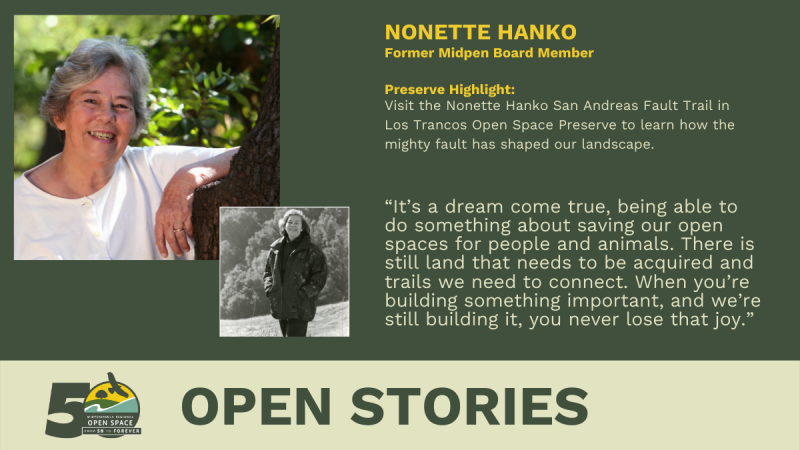
Midpen’s 50th anniversary celebrations would not be complete without recognizing Nonette Hanko. She spearheaded the grassroots movement that led to the creation of Midpen by voters in 1972, and served 46 consecutive years on our publicly elected board of directors from 1972-2018. This year, she was selected as a local conservation hero by the Bay Nature Institute, and we are celebrating this well-deserved award and her legacy as a champion of open space.
Hanko was born and raised on the Peninsula where a love of music and time spent in nature shaped her childhood. An aspiring concert pianist, she studied music at San Francisco State University before marrying and moving to Palo Alto in 1950.
In the late 1960s, a recall of Palo Alto City Council members and Stanford University’s proposed development of Coyote Hill began drawing Hanko out to public meetings.
“I’d lost the wild places I had as a little girl. In Palo Alto there were NO TRESPASSING signs all the way to Skyline. Coyote Hill was one of the few places I could go and hear nothing but bird song,” Hanko said in recalling why she’d wanted to create Midpen.
Palo Alto Times reporter Jay Thorwaldson published an editorial on February 16, 1970, proposing that if conservationists really wanted to preserve land on the rapidly developing Peninsula, they should follow the lead of the East Bay community in creating an agency capable of acquiring land in the public trust. After reading it, Hanko cried herself to sleep and awoke the next morning inspired to take action.
She planned a meeting at her house, inviting everyone she knew who might be able to help create a local open space district. Over homemade blueberry coffeecake, Hanko galvanized a movement that has shaped our region.
“It’s a dream come true, being able to do something about saving our open spaces for people and animals. There is still land that needs to be acquired and trails we need to connect. When you’re building something important, and we’re still building it, you never lose that joy.”
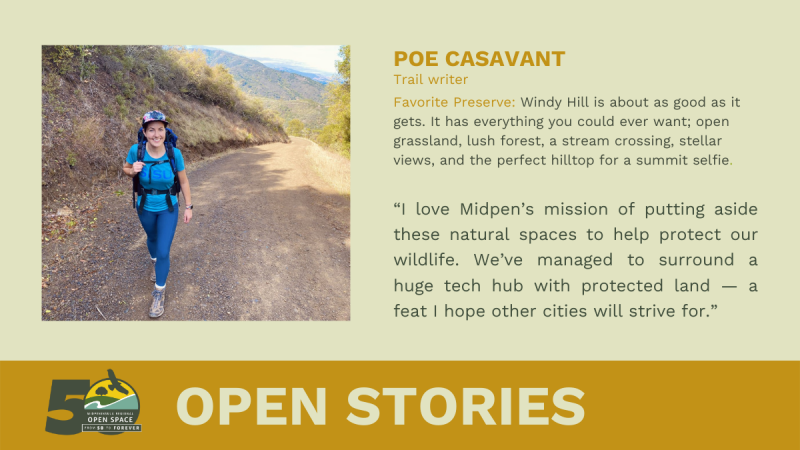
Nature is where Poe Casavant thrives. When she isn’t working as a writer or robotic prop and hairpiece designer, you can find her outdoors – crashing through the waves in her kayak, leading a marathon hike, jumping out of airplanes or training for her current goal of climbing the highest peak on every continent.
“Nature is where I go to reset,” says Poe. “Living in such a fast-paced part of the country, walking through the parks is like a dose of therapy. It lets you shake off the stress of the day and catch your breath.”
Even in her day job, Poe stays connected to nature. As a trail writer for Weekend Sherpa, a publication that connects Californians to local nature, Poe Casavant spends a lot of time writing and thinking about the Bay Area’s greenbelt. Her stories about St. Joseph’s Hill, Rancho San Antonio, Picchetti Ranch, Russian Ridge, Skyline Ridge, Sierra Azul and more highlight the unique features of each preserve, and show how easily accessible beautiful views, great hikes and protected wildlife areas are from the Bay Area’s busy suburbs and urban cores.
For Poe, it is important that everyone feels like nature is for them. “You can find all walks of life on the trails: young, old, rich, poor, newbie or hardened athlete, and almost everyone will slow down to say hello and chat about the sights.”
Check out Poe’s Weekend Sherpa articles if you want to learn more about the greenbelt in your backyard.
Rusmore was the San Mateo County Advocate for Committee for Green Foothills in the 1960s. “Her enthusiasm, warm smile and laughter were tremendous assets in convincing decision makers to protect the Skyline and coastal areas of San Mateo County.” said Green Foothills’ Legislative Advocate Lennie Roberts.
While raising her family in Ladera in the early 1970s, she started a hiking group called the Walkie Talkies that still meets monthly. Later, she turned her attention to documenting the area’s trails. Between 1982 and 2008, Rusmore – along with friends and co-authors Frances Spangle and Betsy Crowder – hiked miles of trails as research for a series of local trail guides. The first book published, Peninsula Trails, was one of the early guides to Midpen trails. “These were hidden gems,” Rusmore once said. “Nobody knew about the trails. They didn't tell anybody.” The book can still be found on the shelves of long-time Midpen staff.
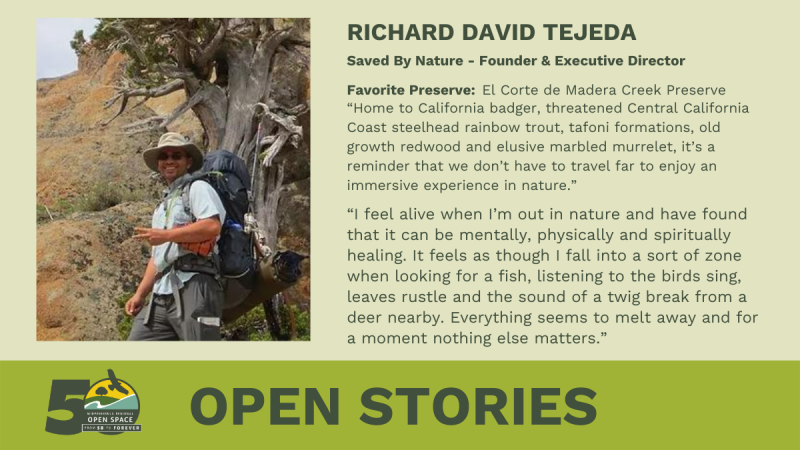
Richard Tejeda knows first-hand the power of nature to transform a life. While growing up in South San Jose he became familiar with the revolving-door system many youth and adults can suffer due to social injustice. “I was surrounded by negativity like drug dealers, drug addicts—including family members,” he says. “Nature literally saved my life. I was supposed to be a statistic, but I couldn’t let that happen. I had to reinvent myself, and nature was a positive escape from the everyday negativity of my neighborhood."
Bad decisions as a youth had him stuck in a seemingly hopeless situation. He altered his path when he began fishing in Santa Clara County Parks – immersing himself in nature to escape his troubled past and surroundings. The time spent outdoors inspired him to return to school, eventually graduating cum laude from San Jose State University with a B.A. in environmental studies and a minor in sustainable water resources. He also began sharing his love of nature with the community in roles at a host of local organizations: Santa Clara Valley Open Space Authority, Guadalupe River Park Conservancy, Santa Clara Valley Water District, Environmental Volunteers and California State Parks.
Tejada founded Saved By Nature in 2018, with the goal of introducing and connecting people of all backgrounds, ethnicities and abilities to the natural wonders and recreational opportunities of the outdoors. He has been recognized by the Santa Clara County League of Conservation Voters as 2020 Environmentalist of the Year and as Bay Nature’s 2022 Community Hero. He’s clearly blazing a trail for others to follow.
Funds provided by the Midpen grantmaking program will allow Saved By Nature to provide field trips to Midpen preserves for students from Davis Jr. High, Stipe Elementary, and Edenvale Elementary.
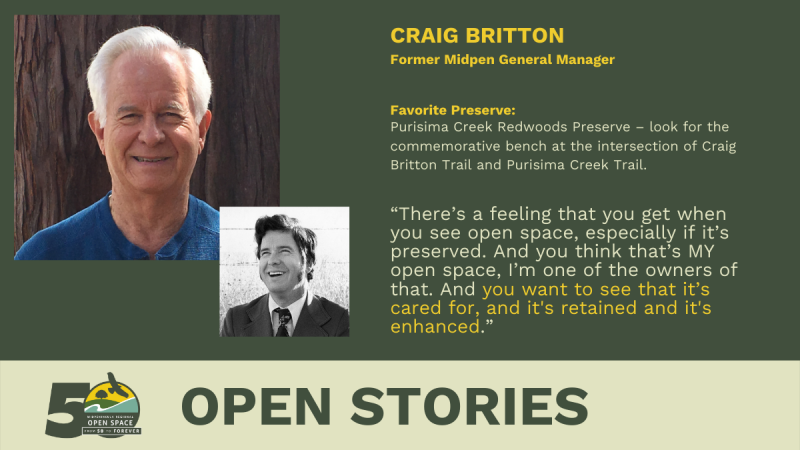
Much of the land protected by Midpen can be attributed to the efforts of former General Manager Craig Britton. After joining Midpen in 1977 as land acquisition manager, Britton was promoted to assistant general manager in 1979 and served as the District’s second general manager from 1994 until his retirement in 2008. During his time at Midpen, the District grew from just eight preserves to the 26 we now own and manage!
Imagining a scenic corridor along Skyline Boulevard, Britton led Midpen in connecting a greenbelt of open space preserves in the Santa Cruz Mountain region. He liked to be in the thick of things and his favorite memories are of the tough negotiations, where he could find a bargain price or leverage grant funding for a purchase. “Some of the toughest negotiations were not the external one, but internal ones,” he remembers, “to decide that [a property] had a high enough priority and a need as we looked at a whole network of trail connections and habitat values.”
Britton also led Midpen to work with the local Coastside community to extend the district boundaries to the San Mateo County coast in 2004. The Coastside Protection Area has now protected over 11,000 acres of natural and agricultural lands that contribute to the area’s rural identity, natural beauty and quality of life.
“The natural world is what sustains us,” Britton, reflecting on his time at Midpen, said. “Even if you never step foot on the land, there’s a feeling that you get when you see open space, especially if it’s preserved. And you think 'that’s my open space, I’m one of the owners of that.' And you want to see that it’s cared for and it’s retained and it’s enhanced.”
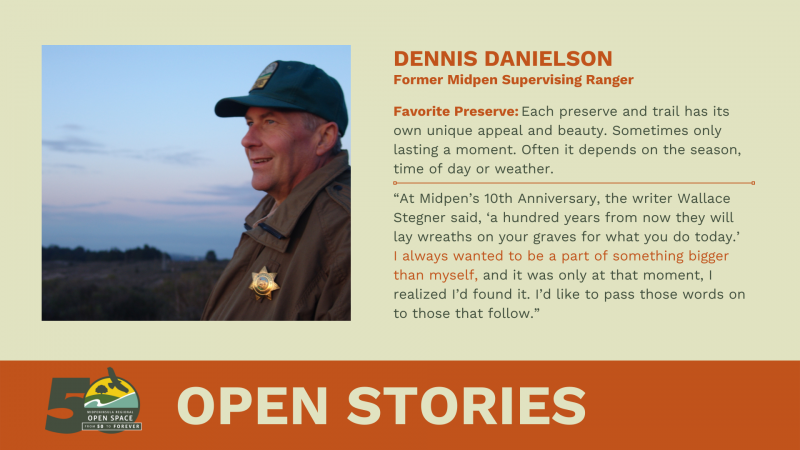
Dennis Danielson joined the Midpeninsula Regional Open Space District as a ranger in 1979, joining some of the first to be hired by newly formed agency. “When I was hired there was no maintenance staff so the ranger staff ‘did it all’. We were the ambassadors and face of the District. Building and maintaining trails was a major element as well as enforcing the regulations, responding to emergencies and providing information to visitors.”
Danielson was inspired to become a ranger as a teenager after assisting in a rescue during a family vacation to Lassen National Park. He worked as a seasonal employee at East Bay Regional Parks and Sequoia National Park before landing a job at Midpen. After eight years he promoted to supervising ranger. “My entire career was ‘in the field’. It was a good fit for me and matched my interests and skill set,” Danielson remembers. “Rangers are at our best when the situation is at its worst. It’s always a team effort – fire departments, sheriff’s deputies, dispatch, medical evacuation helicopters – we know the preserves and how to reach someone in need.”
After years of watching Midpen grow from the front lines, Danielson is thankful for his experience. “I took great pride in being the first boots on the ground of a newly acquired property and installing the first preserve sign,” he recalls. “I had the advantage of living on a preserve as a resident ranger for most of my career, providing 24-hour response for emergencies when needed. I lived at Monte Bello, Purisima Creek Redwoods and Skyline Ridge. An early morning run would offer a view south towards the Monterey Bay. In the summer the fog would shroud the redwood valley of the Pescadero drainage below with Butaño Ridge appearing above like a floating island. In the spring the wildflowers on Russian Ridge would cause me to pause. In the winter there would be clear views in every direction. On the clearest of days you could see north to Mount Tamalpais and the snow covered Sierra through a gap in the east bay hills.”

As a Bay Area transplant, Joel Gartland was looking for ways to get to know the region. What he found was the Bay Area Ridge Trail. Enamored by the vision of circumnavigating the San Francisco Bay through connected hiking and cycling trails on the region’s ridgelines, he began attending meetings, learning about different trails, preserves and areas to explore. His curiosity propelled him to begin participating in volunteer events, join the Board of Directors and eventually become the organization’s Volunteer and Events Coordinator.
When he worked for the Ridge Trail, Gartland partnered closely with Midpen staff. “I was consistently impressed,” he said. “We did large trail events and numerous volunteer trail workdays with the District.” One annual event he organized, Ridge Trail Cruz, organized hikers, bicycle riders and equestrians to travel along the Ridge Trail through Russian Ridge Open Space Preserve, Skyline Open Space Preserve, Long Ridge Open Space Preserve, Castle Rock State Park and multiple county parks.
The Ridge Trail and Midpen work collaboratively to form a network of regional trails to connect people to preserves and a variety of other open spaces, improve access for bicyclists and equestrians and enable visitors to explore farther without having to leave the trail system. With over 400 miles of completed Ridge Trail, there is no shortage of breathtaking views and sections. However, when pressed to name a favorite, Gartland hesitated, “I just love the concept…there are so many beautiful sections here; Russian Ridge, Long Ridge, Purisima Creek Redwoods…”
Trail interconnections can improve safety by reducing the need for trail users to walk or ride on roads between preserves and parks. The Ridge Trail and other regional trails exemplify the big picture of land conservation efforts in the region. Protecting the natural environment and preserving open space is a collaborative effort between land-management agencies, regulatory agencies, non-profits like the Ridge Trail Council, private landowners and the public.
“I look forward to new open spaces and being able to ride from one end of the District to the other on the Ridge Trail.”
He began his journey as a Midpen volunteer a few years ago when he joined a volunteer group project removing French broom at St. Joseph’s Hill Open Space Preserve. “It was a blustery day with a bit of rain, and we were pulling big broom plants up to 10 feet tall,” said Abe. “It was hard work and muddy, but from that first day I was hooked!”
“When I'm pulling weeds, I often get into a meditative frame of mind — it is so nice to clear one's mind for a little while.”
Last year’s impressive California poppy bloom along the Rogue Valley Trail in Rancho San Antonio Open Space Preserve was partially the result of five years of Abe’s hard work in Midpen’s Advanced Resource Management Stewards (ARMS) program. ARMS volunteers coordinate with us to adopt a location within a preserve and work independently on a wide range of tasks that assist in our complex open space restoration.
Abe has been diligently surveying the area and removing invasive yellow starthistle and Italian thistle so that endemic species like our state flower can proliferate. Of the many projects that he has tackled with Midpen, this is the one that he is most proud of. “It has been a big job, and I've worked it several years. It is much better now than when I started and so I feel this project is a success.”
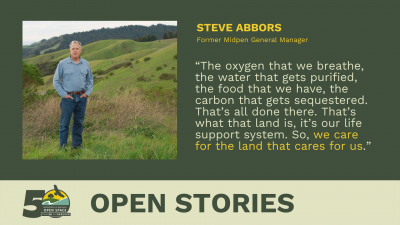
Former Midpen General Manager Steve Abbors is a naturalist at heart. In conversation he casually throws out facts about birds and butterflies. He logs hundreds of trail miles per month.
Caring for the land was a main driver throughout his career. “If you look at a map of the Bay Area, it’s surrounded by this great, green area of land in public ownership,” Abbors explains. “The oxygen that we breathe, the water that gets purified, the food that we have, the carbon that gets sequestered. That’s all done there. That’s what that land is, it’s our life support system. So, we care for the land that cares for us.”
After growing up and spending the majority of his career in the East Bay with lengthy stints at East Bay Regional Parks and the East Bay Municipal Water District, Abbors moved across the bay and finished out his career as Midpen’s general manager from 2008 through 2017.
While at the helm of Midpen, Abbors led the District in the creation of a public vision plan, working together with the public to chart a 40-year course forward. This plan helped Midpen realign our focus to equally embrace all elements of our braided mission: preservation, protection, education and enjoyment. The subsequent passage of Measure AA, a $300 million general obligation bond approved by voters in 2014, followed, and allowed Midpen to complete, among many other projects, the long-awaited opening of the Mount Umunhum summit in 2017.
In one of his final acts as General Manager, Abbors oversaw the creation of a conservation easement over the Mount Umunhum summit with the Amah Mutsun Tribal Band. Mount Umunhum is a sacred site to the Amah Mutsun people and is central to their creation story. “We view the conservation easement a unique opportunity, and a responsibility, to help reconnect the Amah Mutsun people with their culture. That connection, to their culture and the land that supported it, was severed centuries ago,” Abbors said when the agreement was first approved.
When asked to name his favorite preserve or trail, Steve hesitates before calling out the former PG & E Trail in Rancho San Antonio Preserve – now named the Stephen E. Abbors Trail. During his time at Midpen, Steve hiked this trail nearly every day after work. “You get a lot of exercise, but it’s also a place where you can see wildlife…rabbits, deer and pale swallowtail butterflies,” Steve remembered.
Once a naturalist, always a naturalist.
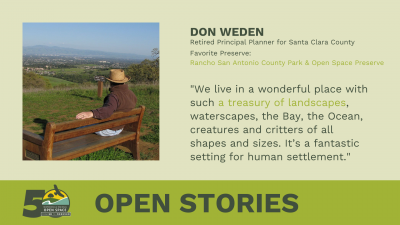
Perched high above the sprawling neighborhoods, downtowns and business districts of Silicon Valley, Don Weden often thinks about balance. The need for intelligently designed urban cores needs to be juxtaposed by nearby, easily accessible open space. “I’ve always been drawn to the 30,000-foot view,” he said as he explained both his penchant for sweeping vistas and his career in long-range planning.
In his 32 years as a Planner for Santa Clara County, Weden has been involved in crafting Master Plans for the County and Midpen, helping guide the future of the region. “Fifty years ago, most of the regional parks, trails and public open space lands did not exist,” he said. “We have an excellent ecosystem in this county of agencies, advocates and nonprofit organizations that helped create and now expand open space preservation.” The key efforts and decisions made in the 1970s laid the roots for subsequent successes.
As the population has grown and suburban communities have become more urban in character, “these preserves have been an important element of the quality of life that we have enjoyed,” Weden said. He believes one of the keys to Midpen’s success over the years has been the quality and professionalism of the staff, both in its offices and out in the field. “That quality and the high standards they have set has given residents a system of outstanding open space preserves that they – and future generations – can use, enjoy, and be proud of.”
Although he retired nearly 20 years ago, Weden continues to stay be involved in the development of the region. He served on the advisory committee for Midpen’s 2014 Vision Plan and has given hundreds of lectures and presentations on the future of the county and region advocating for smart growth and preparing for an aging county.
When not in front of a crowd, he’s often visiting his favorite open space preserve, Rancho San Antonio, hoping to spot his favorite animals, newts. Visiting usually once a week, he marvels that every time is a new time, whether it’s a spotting new wildflower bloom or observing wildlife – something his late wife Kim often remarked on. “We live in a wonderful place with such a treasury of landscapes, waterscapes, the Bay the Ocean, creatures and critters of all shapes and sizes," he said. "It’s a fantastic setting for human settlement.”
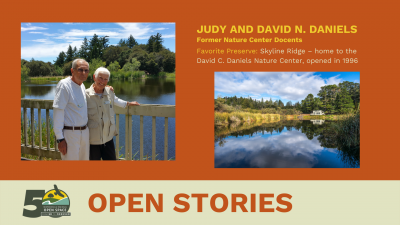
As we prepare to welcome visitors back to the David C. Daniels Nature Center next Saturday, April 2, this week Open Stories remembers Judy and David N. Daniels. As nature center hosts and significant contributors to Midpen, Judy and David felt honored to welcome countless weekend visitors to the David C. Daniels Nature Center (established and funded in large part by the Daniels' and named in memory of their son).
Judy began volunteering for Midpen in the mid-1990s as a Nature Center and an Outdoor Education Docent. In 2002, David and Judy felt the role of Nature Center Docent was meaningful volunteer work to pursue as a couple and did so together for 13 years. The Daniels were remarkable people and deeply committed to open space conservation and enriching the experiences of others.
Supporting opportunities for contemplation, education and recreation was always precious to David and Judy. It was their hope that people will become inspired by visiting open spaces and it would foster an appreciation for, and stewardship of, the natural environment.
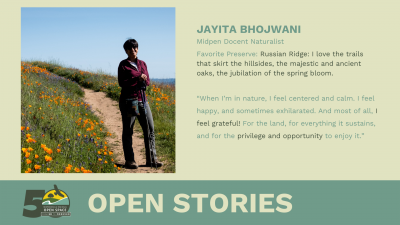
Shortly after moving to the Bay Area to work in tech, Jayita Bhojwani took a hike that would change the course of her career. “I had signed up to attend a docent-led wildflower hike at Russian Ridge and came back completely awed – by the enormity of Midpen’s story of the land they’d protected, by the magnificence of the vistas, and by the wildflowers, which felt nothing short of miraculous,” said Jayita.
“My experience led me to attending many more docent hikes over the years, and I was inspired by the many docents I hiked with – their knowledge, their love of nature, and their willingness and enthusiasm to share this with the public. With each hike, my horizons widened, my appreciation of the world around us grew, and I eventually decided to apply to the program myself – to deepen my own understanding as well as to be able to give back and share this beauty and wonder with the public.”
Since 2016, Jayita has been an indispensable member of Midpen’s volunteer and docent-naturalist programs. She was also inspired to take care of nature, not just as a hobby but as a career.
“My involvement with Midpen through its hikes and the docent program, and learning about California’s natural and cultural history, eventually led me to change careers, to focus on using technology for social good,” says Jayita. “I left the high-tech world and now work for a non-profit that assists others with technology and mapping, in the fields of conservation, recreation, education, public health, and social equity. I will always be grateful to Midpen…for the inspiration and encouragement.”
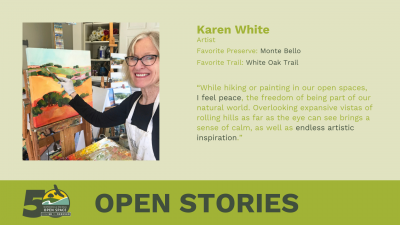
Karen White’s oil paintings capture the vibrant color of Bay Area open space through every season. Not only does Karen paint scenes depicting open space, but she also paints outdoors in open space. She will often paint small color studies “en plein air,” and then return to the studio to create larger, stylized versions of the small paintings she created while out in open space.
According to Karen, “painting Bay Area landscapes – Midpeninsula Regional Open Space Preserves, County parkland, community gardens and more – [is] part of who I am as an artist.” She first discovered Midpen’s preserves not as a painter, but as a parent.
“As one of several field trip drivers for students at Duveneck Elementary School, I had the chance to visit Deer Hollow Farm at Rancho San Antonio Preserve,” says Karen. “The goats, of course, were a highlight with the children! At Los Trancos Preserve, we saw the shifted ground during fascinating ranger-led earthquake hikes along the Nonette Hanko San Andreas Fault Trail. I discovered the fantastic views from Skyline overlooking La Honda Creek Preserve all the way to the Pacific.”
Later, she would return to these spots that she had discovered in order to paint them. Monte Bello Open Space Preserve has become one of her go-to painting spots. She especially appreciates the “amazing views at every point along White Oak Trail.”
“While hiking or painting in our open spaces, I feel peace, the freedom of being part of our natural world. Overlooking expansive vistas of rolling hills as far as the eye can see brings a sense of calm, as well as endless artistic inspiration.”
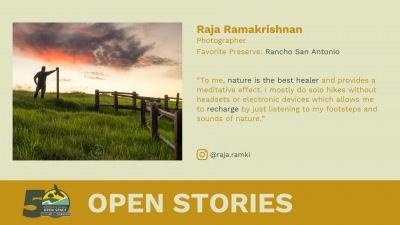
Raja Ramakrishnan travels the world with his camera, capturing nature “in its most pristine form.” His photos show us glimpses from Singapore, New York, Vermont, Hawaii, and southern India’s wash of lush green. From first light to nightscapes, backpacking camps to busy city streets and lighthouses to cathedrals, Raja calls himself the chaser of light. Luckily for us, Midpen is one of his regular chasing grounds. His first preserve visit was to Rancho San Antonio Open Space Preserve back in 2004.
Since then, he has captured sunset rays streaming through the tree line on Black Mountain ridge, shadows falling across the rolling hills of Monte Bello, and California poppies en masse as they rise to greet the day. “After a busy work week, I look forward to going on hikes,” says Raja. “I am able to stay fit by hiking...and taking nature photographs in local areas without traveling 4-5 hours to Yosemite or the Sierra Nevada region.”
“To me, nature is the best healer,” says Raja. “[It] provides a meditative effect. I mostly do solo hikes without headsets or electronic devices, which allows me to recharge by just listening to my footsteps and the sounds of nature.”
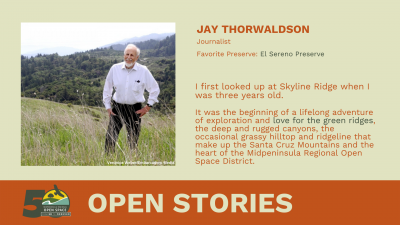
Growing up in Los Gatos below what is now Midpen’s El Sereno Open Space Preserve, Jay Thorwaldson learned to ride a horse when he was just 3 years old. He spent his childhood riding the ridges and valleys of the Santa Cruz Mountains, exploring from Mount Umunhum to the town of Alma, now under Lexington Reservoir. Growing up with near unlimited access to these hillsides instilled in him the importance of permanently protecting the land for future generations.
With such a beginning, it’s not surprising that Thorwaldson played a key role in the formation of the Midpeninsula Regional Open Space District. Working as a reporter for the Palo Alto Times, he created a beat for himself covering the region’s parks, open spaces and baylands. When Nonette Hanko, a Midpen founder and former board director, expressed to him her concerns about losing the wild places she knew as a child, he sparked an approach she hadn’t considered. “I told her environmentalists needed to do what they did in the East Bay in 1933, in the depths of the Great Depression, and form a park district to buy the land at fair market value in order to safely preserve it in perpetuity,” Thorwaldson recalled.
Thorwaldson shared that conversation with his editor, Alexander Bodi, who asked him to draft an editorial on the subject, which ran on February 16, 1970. That editorial, in turn, gave Hanko the path she needed to organize others toward a lasting solution.
“For me there are three takeaways,” Thorwaldson said. “A knowledge of history is important in mapping future choices. The press has a vital role to play in terms of presenting information and ideas that can generate the all-important responses from individuals and, as Margaret Mead once observed, one person working with others can make a huge difference – in this case a 65,000-acre difference — for many generations to come.” Thorwaldson retired in 2011 after a 50-year career in journalism. He now lives in El Dorado County, still surrounded by open space and exploring the trails.
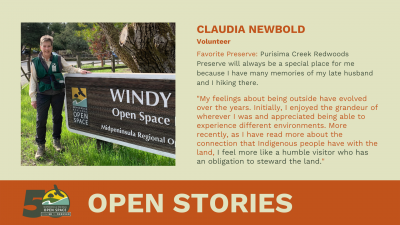
After retiring from a career in finance in 2001, Claudia Newbold wanted to “do something useful.” This meant finding out how to help care for the open space that she loves so deeply. Claudia first became interested in protecting open space when she and her late husband were hiking the trails together and began attending some of Midpen’s docent-led hikes.
In 2003, Claudia joined Midpen’s Volunteer Trail Patrol program. Visitors to Windy Hill Open Space Preserve may have encountered her as she does her twice-weekly patrol of the trails there. Claudia hikes over 10 miles during each patrol as she answers questions from visitors, and reports hazards like fallen trees. “Claudia has over 7,000 hours of service in her more than 20 years with Midpen” said volunteer program manager Jen Williams. “She is such a wealth of knowledge. She knows exactly which trails to hike after storms to immediately report trail repair needs.”
As a Midpen volunteer, Claudia has worn many hats. In addition to Trail Patrol, she has also assisted at community events, volunteered in our office and served as a Land Steward (formerly known as Preserve Partners), removing invasive species from the preserves. However, her favorite project has been documenting the memorial benches and markers throughout the preserves and researching the people they commemorate.
Over the past 20 years, Claudia has hiked all 247.5 miles of trail at Midpen, but Purisima Creek Redwoods Open Space Preserve will always hold a special place in her heart because of the many memories that she made while hiking there with her late husband.
Claudia hopes that everyone finds the same joy that she does in open space: “Whenever I can, I try to introduce others to these wonderful spaces and share what I have learned.”
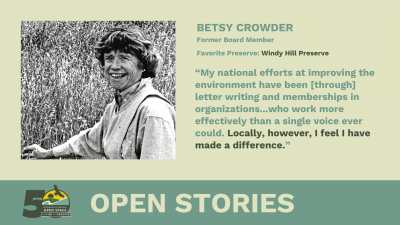
An advocate, environmentalist and public servant through and through, Betsy Crowder dedicated much of her life to the preservation and the restoration of natural habitats within the Santa Cruz Mountains.
Her early love of the outdoors was sparked by her family’s regular camping trips in the province of New Brunswick, Canada. A Boston native, she moved to the Peninsula in 1948 to attend Stanford University. While there, she began to understand the collective power of organized advocacy through her participation in multiple environmental and civic organizations such as the Audubon Society, Wilderness Society, Sierra Club, Nature Conservancy and the League of Women Voters.
Never one to back down from a cause she believed in, Crowder was known for her passionate spirit and unabashed candor. Crowder was appointed to the Midpen board in 1989, serving until her death in 2000. During her tenure Midpen increased its holdings of open space on the Peninsula from 29,000 to 43,000 acres and expanded to the San Mateo County coast. Crowder was an active and a contributing member of the California Native Plant Society, San Mateo County Trails Committee, Bay Area Ridge Trail Council, Bay Area Open Space Council and Committee for Green Foothills.
Her legacy lives on through the Betsy Crowder Trail in the Windy Hill Preserve. The half-mile trail runs past Sausal Pond where you may be treated to sights of egrets, blue herons, wood ducks, dragonflies or even the western pond turtle.
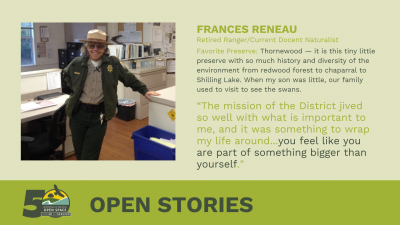
In 1998, Frances Reneau decided to reevaluate her life. “I was 43 and going through a midlife crisis in my career,” she recalls, “I wanted a change.” Having worked seasonally with Midpen in the past, she knew spending her time outdoors brought meaning to her life, but she wasn’t sure which career path was right for her. After speaking with a few Midpen rangers, Frances decided to apply to be one of them. She got the job.
Before becoming a ranger, Frances enjoyed other careers but quickly realized that this was where she belonged. “Being a ranger is a total life highlight,” she says. “The mission of the District jived so well with what is important to me, and it was something to wrap my life around.” Frances had so many unforgettable experiences that she decided to write about them in her memoir, Ranger Chick, which features many exciting tales of her life in green pants.
“I’ve lived in places with little park or open space lands — when you don’t have open space, you miss it,” says Frances. She believes there is a part of every person that loves the feeling of looking out into open land and only seeing vistas and nature. Frances knows firsthand how overwhelming it can feel to care for open space but is not ready to throw in the towel yet, “we need to do our best to make the land healthy for the future.”
Even though Frances is now retired, she still spends her time at Midpen volunteering as a docent naturalist. For many years, Frances has dreamed of leading a series of 24 hikes in the preserves. This year, as part of Midpen’s 50th anniversary, Frances has made her dream a reality with the All Preserves Great & Small hike series. “I will feel very proud when this has been accomplished,” says Frances “what better way to honor the district than to visit these preserves and talk about what makes them special.”
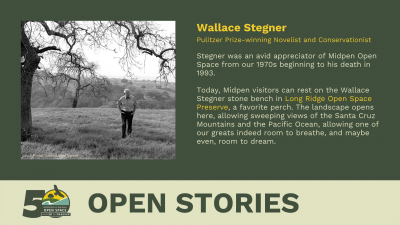
For this Open Story, we honor the late Wallace Stegner, Stanford’s own Pulitzer Prize-winning novelist and dedicated conservationist. Stegner was an avid appreciator of Midpen Open Space from our 1970s beginning to his death in 1993. Given his place in history as one of the most venerable voices of the American West, it’s easy to imagine how his time in the open space fed his passion for the sanctity of the outdoors. His 1960 “Wilderness Letter” helped Congress pass the 1964 Wilderness Act, establishing the national wilderness preservation system.
In his letter he wrote:
Something will have gone out of us as a people if we ever let the remaining wilderness be destroyed…if we pollute the last clear air and dirty the last clean streams and push our paved roads through the last of the silence. We simply need that wild country available to us, even if we never do more than drive to its edge and look in. For it can be a means of reassuring ourselves of our sanity as creatures, a part of the geography of hope.
Today, Midpen visitors can rest on the Wallace Stegner stone bench in the Long Ridge Open Space Preserve, a favorite perch. The landscape opens here, allowing sweeping views of the Santa Cruz Mountains and the Pacific Ocean, allowing one of our greats indeed room to breathe, and maybe even, room to dream.
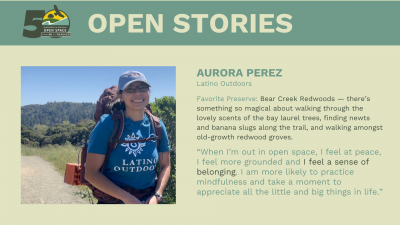
Born and raised in Southern California, Aurora Perez’s earliest outdoor memories are of camping trips in the Angeles National Forest. She celebrated many birthdays together with her family amongst the trees, in the snow and under the stars.
After earning her bachelor’s degree in Environmental Horticulture and Urban Forestry from UC Davis, Perez began her career in the SF Bay Area with positions at the National Park Service, Golden Gate National Parks Conservancy and Marin Water.
Her first introduction to Midpen came at a wildflower walk led by Latino Outdoors at Russian Ridge in 2019. “It was such an awesome welcome!” Perez recalls. “I got to learn and identify lots of beautiful wildflowers with the Latino Outdoors community and make connections to people, plants and the open space.”
Perez now helps share her knowledge about recreating responsibly in the outdoors as the SF Bay Area Regional Coordinator for Latino Outdoors. You can see her in some of the videos and virtual presentations we’ve produced with LO. If you see her out on the trail be sure to say hello!
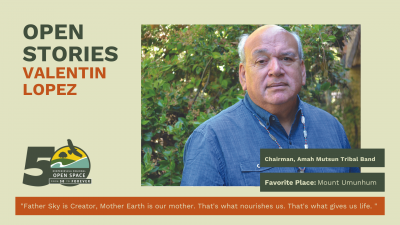
Valentin Lopez had recently been elected chairman of the Amah Mutsun Tribal Band when the elders paid a visit. They said we needed to get back to taking care of Mother Earth and all living things, Lopez explained. “We didn’t know how we were going to do that because whenever we would look at the lands, we’d see ‘private property,’ ‘keep out,’ ‘no trespassing,’” he said. “So, we did what we always do, we prayed. We prayed as a tribe, asking Creator to help us find a way back.”
Read More
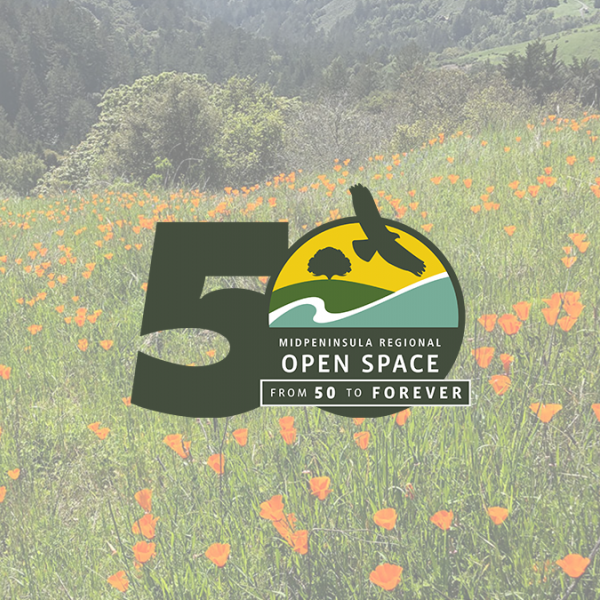
Caring for the Land that Cares for Us. Fifty years ago, our community prioritized clean air and water, healthy habitats for diverse native plants and animals, ecosystems that are resilient to the effects of our changing climate and places for people to connect with nature – that's what Midpen provides in perpetuity.

